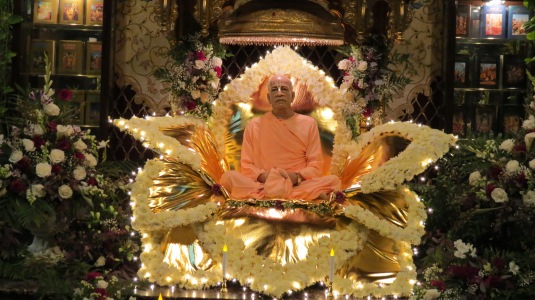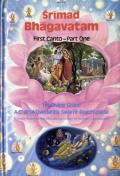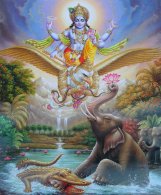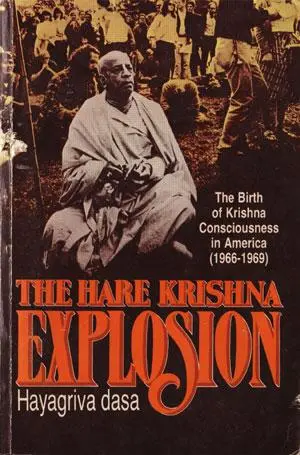27 Oct 2014
by The Hare Krishna Movement
in A.C. Bhaktivedanta Swami Prabhupada, Lokadrsti devi, Vyas-puja, Vyasasan das, Vyasasana
Tags: A.C. Bhaktivedanta Swami Prabhupada, bhagavad-gita, disappearance day of Srila Prabhupada, Hari Nama devi, Krishna, lokadrsti devi, Maha Laxmi devi, Pushpanjali, Srila Prabhupada, Vyasasan das, Vyasasana

click on images to enlarge
Picture taken before Guru-puja
Today we honored His Divine Grace A. C. Bhaktivedanta Swami Prabhupada’s disappearance day here at New Vrindavan Farm Community, with beautiful offerings, a Pushpanjali (an offering of flowers) followed by an amazing feast The beautiful Vyasasana decoration was done by Her Grace Lokadrsti devi dasi, with assistance from Hari Nama, Maha Laxmi, and Christine prabhus. More
26 Oct 2014
by The Hare Krishna Movement
in A.C. Bhaktivedanta Swami Prabhupada, Bhagavata Dharma Discourses, Conversation with Srila Prabhupada, Jon Nordheimer, New Vrindavan
Tags: A. C. Bhakthvedanta Swami Prabhupada, Bhagavata Dharma Discourses at New Vrindavan, chant the name of Lord Krsna, His Divine Grace A. C. Bhaktivedanta, janmastami celebration at new vrindavan, Jon Nordheimer, New Vrindavan farm community, New York Times reporter, open pavilion

This is the beginning of a new series of Lectures entitled “The Bhagavata Dharma Discourses” which were held at New Vrindavan Farm Community in 1972. It was the third annual Janmastami Celebration held at New Vrindavan, and devotees poured in from everywhere, and even a New York Times Reporter appeared. “On the crown of a lovely green hill in the West Virginia contryside,” his article read, “under the aluminum roof of an open pavilion, the faithful gathered to chant the name of Lord Krsna and kneel at the feet of their spiritual master…A.C. Bhaktivedanta Swami Prabhupada.”
An interview held during the Bhāgavata Dharma Discourses at New Vrindaban, September 2, 1972. Śrīla Prabhupāda is interviewed by John Nordheimer of the New York Times.
More
25 Oct 2014
by The Hare Krishna Movement
in A.C. Bhaktivedanta Swami Prabhupada, Damodara, Gopis, Srimad Bhagavatam
Tags: A.C. Bhaktivedanta Swami Prabhupada, affection of the gopis, damsels of Vraja, ecstasy, gopis, Krsna, Lord Krsna, remembrance of Lord Krsna, SB3.2.14, Srimad Bhagavatam, transcendental love, Vrndavana

click on image to enlarge
In our attempt to stay focused on the childhood pastimes of Lord Krsna throughout this month of Damodara, we were reading from the Third Canto of the Srimad-Bhagavatam, chapter 2, entitled; “Remembrance of Lord Kṛṣṇa”. The great devotee Uddhava, was asked by Vidura, to speak on the messages of Lord Krsna. The following is but one of the verses and purports from this famous chapter.
…In His boyhood at Vṛndāvana, Lord Kṛṣṇa was notorious as a teasing friend in transcendental love to all the girls His age. His love for them was so intense that there is no comparison to that ecstasy, and the damsels of Vraja were so much attached to Him that their affection excelled that of the great demigods like Brahmā and Śiva. Lord Kṛṣṇa finally admitted His defeat before the transcendental affection of the gopīs and declared that He was unable to repay them for their unalloyed affection. (from purport to SB 3.2.14)
Full text and purport More
24 Oct 2014
by The Hare Krishna Movement
in A.C. Bhaktivedanta Swami Prabhupada, Festivals, Govardhana-puja
Tags: A.C. Bhaktivedanta Swami Prabhupada, Bhaktivedanta purports, Govardhana Hill, Govardhana-puja, Krsna Book, Krsna consciousness movement, Lord Krishna, Worshiping Govardhana Hill

Today in honor of Govardhana-puja, we are posting the entire chapter from Krsna Book, entitled “Worshiping Govardhana Hill”
…The sacrifice known as Govardhana-pūjā is observed in the Kṛṣṇa consciousness movement. Lord Caitanya has recommended that since Kṛṣṇa is worshipable, so His land, Vṛndāvana and Govardhana Hill, are also worshipable. To confirm this statement, Lord Kṛṣṇa said that Govardhana Pūjā is as good as worship of Him. From that day, the Govardhana Pūjā has been still going on and is known as Annakūṭa. In all the temples of Vṛndāvana or outside of Vṛndāvana, huge quantities of food are prepared in this ceremony and are very sumptuously distributed to the general population. Sometimes the food is thrown to the crowds, and they enjoy collecting it off the ground. From these instances, we can understand that prasādam offered to Kṛṣṇa never becomes polluted or contaminated, even if it is thrown on the ground. The people, therefore, collect it and eat with great satisfaction.
More
24 Oct 2014
by The Hare Krishna Movement
in Festivals, Govardhana-puja
Tags: cow protection, cows in front, festivals, Gopal, govardhana, Govardhana Hill, Govardhana-puja, Lord Krsna's lifting of Govardhana hill, protector of cows, vaishnava holidays

Today marks the annual celebration of Lord Krishna’s lifting Govardhana Hill to protect the residents of Vrindavana from the wrath of Indra. Typically devotees prepare varieties of foodstuff with grain and ghee (like rice, dhal, halva, pakora, puri etc.) and all kinds of milk preparations (such as sweet rice, rabri, sweetballs, sandesha, rasagulla and laddu). The food is stacked like a small mountain and offered to the Lord. Then it is distributed to everyone.
Of all the devotees, this Govardhana Hill is the best! O my friends, this hill supplies Krishna and Balarama, along with Their calves, cows and cowherd friends, with all kinds of necessities: water for drinking, very soft grass, caves, fruits, flowers and vegetables. In this way the hill offers respects to the Lord. Being touched by the lotus feet of Krishna and Balarama, Govardhana Hill appears very jubilant. (Srimad Bhagavatam 10.21.18)
More
22 Oct 2014
by The Hare Krishna Movement
in A.C. Bhaktivedanta Swami Prabhupada, Childhood Pastimes of Krsna, Damodara, Kaliya Serpent, Krishna Consciousness, KRSNA The Supreme Personality of Godhead
Tags: A.C. Bhaktivedanta Swami Ppabhupada, black serpent kaliya, books of Srila Prabhupada, childhood pastimes of Krishna, Damodara, Kaliya, Kartika, Krsna Book, Lord Krsna, month of Damodara, pastimes of krsna, Yamuna river

“O Lord, although You are able to give all kinds of benedictions, I do not pray to You for liberation, nor eternal life in Vaikuntha, nor any other boon. My only prayer is that Your childhood pastimes may constantly appear in my mind. O Lord, I do not even want to know Your feature of Paramatma. I simply wish that Your childhood pastimes may ever be enacted in my heart.” (Damodarasatka prayers)
Continuining our month long attempt to stay focused on the childhood pastimes of Krsna, during this month of Damodara (Kartika), we bring you another exciting chapter from; Kṛṣṇa, the Supreme Personality of Godhead. Today we are posting the chapter entitled “Subduing Kāliya”
Kṛṣṇa, the Supreme Personality of Godhead
By His Divine Grace A. C. Bhaktivedanta Swami Prabhupāda
Chapter Sixteen
Subduing Kāliya
When He understood that the water of the Yamunā was being polluted by the black serpent Kāliya, Lord Kṛṣṇa took action against him and made him leave the Yamunā and go elsewhere, and thus the water became purified.
More
21 Oct 2014
by The Hare Krishna Movement
in A.C. Bhaktivedanta Swami Prabhupada, Lord Rsabhadeva, Srimad Bhagavatam, Threefold Miseries, Transcendental Knowledge, Varnasrama Dharma
Tags: A.C. Bhaktiveanta Swami Prabhupada, amhita, devotional service, eternal blissful life, living entities, Lord Rsabhadeva, material bodies, rsabha uvaca, Srimad Bhagavatam, transcendental knowledge

This morning by chance, I happened upon the teachings of Lord Rsabhadeva to His sons. It was in an old notebook that I opened just to see what was inside. Inside were prayers from the Vaisnava Songbook, the Brahma-samhita, Teachings of Pralada Maharaja, and these teachings of Lord Rsabhadeva. It was Sri Gandhari’s old gurukula study notebook, and what she was studying 30 years ago was very useful and timely today. It was just what I needed to read this morning and I share it with you today. It is verses 1-27, from the Fifth Canto of the Srimad Bhagavatam, chapter five.
Lord Ṛṣabhadeva told His sons: My dear boys, of all the living entities who have accepted material bodies in this world, one who has been awarded this human form should not work hard day and night simply for sense gratification, which is available even for dogs and hogs that eat stool. One should engage in penance and austerity to attain the divine position of devotional service. By such activity, one’s heart is purified, and when one attains this position, he attains eternal, blissful life, which is transcendental to material happiness and which continues forever.
More
20 Oct 2014
by The Hare Krishna Movement
in A.C. Bhaktivedanta Swami Prabhupada, B. G. Sharma Art, Childhood Pastimes of Krsna, Kartika, Krishna Consciousness, KRSNA The Supreme Personality of Godhead, Nalakuvara and Manigriva
Tags: A.C. Bhaktivedanta Swami Prabhupada, art of B.B. Sharma, B.G. Sharma, demigods, ecstatic love, Gokula, Krishna's childhood pastimes, Krsna, Krsna The Supreme Personality of Godhead, liberated, Lord Krsna, lotus feet of the Lord, Mother Yasoda, Nalakurvara and Manigriva, Narada Muni, ropes of Yasoda, wooden grinding mortar

click on image to enlarge
“O Lord Damodara, in Your form as a baby, Mother Yasoda bound You to a grinding stone with a rope for tying cows, You then freed the sons of Kuvera, Manigriva, and Nalakuvera, who were cursed to stand as trees, and You gave them the chance to become Your devotees. Please bless me in this same way, I have no desire for liberation into Your effulgence.” (Damodarastka Prayers)
So…continuining our month long attempt to stay focused on the childhood pastimes of Krsna, during this month of Damodara (Kartika), we bring you another exciting chapter from; Kṛṣṇa, the Supreme Personality of Godhead. Today we are posting the chapter entitled “The Deliverance of Nalakūvara and Maṇigrīva”.
Kṛṣṇa, the Supreme Personality of Godhead
By His Divine Grace A. C. Bhaktivedanta Swami Prabhupāda
Chapter Ten
The Deliverance of Nalakūvara and Maṇigrīva
The story of the cursing of Nalakūvara and Maṇigrīva and their deliverance by Kṛṣṇa, under the all-blissful desire of the great sage Nārada, is here described.
More
18 Oct 2014
by The Hare Krishna Movement
in A.C. Bhaktivedanta Swami Prabhupada, Dharma, Dream
Tags: A. C. Bhaktivedanta Swami Pabhupada, dharma, happiness, living being's eternal occupation, occupation, root meaning of the word dharma, Srimad Bhagavatam, Supreme Lord, that which sustains

This morning I awoke early, and before rising, I was just going over the dreams in my head. I was dreaming about the following verse from the Srimad Bhagavatam.
“The supreme occupation [dharma] for all humanity is that by which men can attain to loving devotional service unto the transcendent Lord. Such devotional service must be unmotivated and uninterrupted to completely satisfy the self.” (SB 1.2.6)
I have been very much absorbed in my worldly occupation of late, writing up contracts, submitting bills, paying employees etc. and have mostly been waking up with thoughts of work. But this morning I was dreaming about a specific verse from the Srimad Bhagavatam. Interesting! So I went to the Bhagavatam, and read the purport to this verse.
…We have purposely denoted dharma as occupation because the root meaning of the word dharma is “that which sustains one’s existence.” A living being’s sustenance of existence is to coordinate his activities with his eternal relation with the Supreme Lord Kṛṣṇa. Kṛṣṇa is the central pivot of living beings, and He is the all-attractive living entity or eternal form amongst all other living beings or eternal forms. Each and every living being has his eternal form in the spiritual existence, and Kṛṣṇa is the eternal attraction for all of them. Kṛṣṇa is the complete whole, and everything else is His part and parcel. The relation is one of the servant and the served. It is transcendental and is completely distinct from our experience in material existence. This relation of servant and the served is the most congenial form of intimacy. One can realize it as devotional service progresses. Everyone should engage himself in that transcendental loving service of the Lord, even in the present conditional state of material existence. That will gradually give one the clue to actual life and please him to complete satisfaction.
Somehow I feel more satisfied, more complete, after my reading.
Full Verse and Purport More
17 Oct 2014
by The Hare Krishna Movement
in A.C. Bhaktivedanta Swami Prabhupada, Srila Prabhupada's Books, Srimad Bhagavatam
Tags: A.C. Bhaktivedanta Swami Prabhupada, Bhaktivedanta purports, brahmajyoti effulgence, Brhaspati, conditioned soul, intelligent man, Lord Brahma, Lord Siva, Maharaja Pariksit, material world, pure devotional service, SB 2.3, Sri Sukadeva Gosvami, Srimad Bhagavatam, threshold of death, Vedas

click on image to enlarge
As we continue to update our (one of our other sites) Śrīmad-Bhāgavatam by posting a chapter at a time, of that great literary work by His Divine Grace Srila Prabhupada, we will continue to share the progress with our readers here at The Hare Krishna Movement.
Śrīmad-Bhāgavatam
by His Divine Grace A. C. Bhaktivedanta Swami Prabhupāda
Canto 2, Chapter Three
Pure Devotional Service: The Change in Heart
More
16 Oct 2014
by The Hare Krishna Movement
in A.C. Bhaktivedanta Swami Prabhupada, B. G. Sharma Art, Kartika, KRSNA The Supreme Personality of Godhead
Tags: A. C. Bhaktivedanta Swami Pabhupada, Bakasura, bifurcate, bifurcated, bifurcating his mouth, cameli flower, cowherd boys, dakasura demon, denizens of the heavenly planets, drums and conchshells, Kamsa, Kartika, Krsna and Balarama, Krsna Book, Krsna The Supreme Personality of Godhead, month of Damodara, river yamuna, The Krishna Art of B. G. Sharma, vibration of bugles

So…continuining our month long attempt to stay focused on the childhood pastimes of Krsna, during this month of Damodara (Kartika), we bring you another exciting chapter from; Kṛṣṇa, the Supreme Personality of Godhead. Today we are posting the chapter entitled “Killing the Demons Vatsāsura and Bakāsura”.
…All the cowherd boys would daily go to the bank of the river Yamunā to water their calves. Usually, when the calves drank water from the Yamunā, the boys also drank. One day, after drinking, when they were sitting on the bank of the river, they saw a huge animal which looked something like a duck and was as big as a hill. Its top was as strong as a thunderbolt. When they saw that unusual animal, they became afraid of it. The name of this beast was Bakāsura, and he was a friend of Kaṁsa’s. He appeared on the scene suddenly and immediately attacked Kṛṣṇa with his pointed, sharp beaks and quickly swallowed Him up. When Kṛṣṇa was thus swallowed, all the boys, headed by Balarāma, became almost breathless, as if they had died. But when the Bakāsura demon was swallowing up Kṛṣṇa, he felt a burning fiery sensation in his throat. This was due to the glowing effulgence of Kṛṣṇa. The demon quickly threw Kṛṣṇa up and tried to kill Him by pinching Him in his beaks. Bakāsura did not know that although Kṛṣṇa was playing the part of a child of Nanda Mahārāja, He was still the original father of Lord Brahmā, the creator of the universe. The child of mother Yaśodā, who is the reservoir of pleasure for the demigods and who is the maintainer of saintly persons, caught hold of the beaks of the great gigantic duck and, before His cowherd boy friends, bifurcated his mouth, just as a child very easily splits a blade of grass. From the sky, the denizens of the heavenly planets showered flowers like the cāmeli, the most fragrant of all flowers, as a token of their congratulations. Accompanying the showers of flowers was a vibration of bugles, drums and conchshells.
This description of Krishna killing the demon Bakasura by bifurcating his mouth, has always intriged me, and after years of hearing and reading this story I finially decided to look up the word bifurcate.
bi·fur·cate
verb
past tense: bifurcated; past participle: bifurcated
ˈbīfərˌkāt/
divide into two branches or forks.
“just below Cairo the river bifurcates”
(from Merriam Webster dictionary)
Full chapter More
14 Oct 2014
by The Hare Krishna Movement
in A.C. Bhaktivedanta Swami Prabhupada, Chanting Hare Krishna, The Hare Krishna Movement, Yoga
Tags: A.C. Bhaktiveanta Swami Prabhupada, chanting Hare Krishna, God realization, Hare Rama, Hari Kirtana, Kali-yuga, kirtan, sankirtan, self relization, supreme absolute truth, Vedic literatures, Visnu

harer nāma harer nāma
harer nāmaiva kevalam
kalau nāsty eva nāsty eva
nāsty eva gatir anyathā
In this Age of Kali there is no other means, no other means, no other means for self-realization than chanting the holy name, chanting the holy name, chanting the holy name of Lord Hari.
[Adi 17.21]
…
This hari-kīrtana was started five hundred years ago in Bengal by Lord Caitanya. In Bengal there is competition between the Vaiṣṇavas and the śāktas. The śāktas have introduced a certain type of kīrtana called kālī-kīrtana. But in the Vedic scriptures there is no recommendation of kālī-kīrtana. Kīrtana means hari-kīrtana. One cannot say, “Oh, you are Vaiṣṇava. You can perform hari-kīrtana. I shall perform śiva-kīrtana or devī-kīrtana or gaṇeśa-kīrtana.” No. The Vedic scriptures do not authorize any kīrtana other than hari-kīrtana. Kīrtana means hari-kīrtana, the glorification of Kṛṣṇa.
So this process of hari-kīrtana is very simple: Hare Kṛṣṇa, Hare Kṛṣṇa, Kṛṣṇa Kṛṣṇa, Hare Hare/ Hare Rāma, Hare Rāma, Rāma Rāma, Hare Hare. Actually there are only three words: Hare, Kṛṣṇa, and Rāma. But they are very nicely arranged for chanting so that everyone can take the mantra and chant Hare Kṛṣṇa, Hare Kṛṣṇa, Kṛṣṇa Kṛṣṇa, Hare Hare. Since we have started this movement in the Western countries, Europeans, Americans, Africans, Egyptians, and Japanese are all chanting. There is no difficulty. They are chanting very gladly, and they are getting the results. What is the difficulty? We are distributing this chanting free of charge, and it is very simple. Simply by chanting, one can have self-realization, God realization, and when there is God realization, then nature realization is included also. (from The Science of Self Realization)
More
14 Oct 2014
by The Hare Krishna Movement
in A.C. Bhaktivedanta Swami Prabhupada, Damodara, Kartika, Krishna Consciousness, Krsna Consciousness, KRSNA The Supreme Personality of Godhead
Tags: A.C. Bhaktivedanta Swami Prabhupada, damodarastka prayers, Kartika, Krsna, Krsna The Supreme Personality of Godhead, month of Damodara, Mother Yasoda Binds Lord Krsna, spiritual subject matter, spiritually enlivening, transcendental subject matter

click on image to enlarge
The beauty of Transcendental subject matter is that it never gets old, but rather, becomes more relishable with every reading. For instance, every year we celebrate the month of Damodara or Kartika, with the reading of “Mother Yasoda Binds Lord Krsna”, and singing the Damodarastka prayers, and every year, it becomes more enjoyable and spiritually enlivening. That is the nature of Spiritual Subject Matter.
Kṛṣṇa, the Supreme Personality of Godhead
By His Divine Grace A. C. Bhaktivedanta Swami Prabhupāda
Chapter Nine
Mother Yaśodā Binds Lord Kṛṣṇa
Once upon a time, seeing that her maidservant was engaged in different household duties, mother Yaśodā personally took charge of churning butter. And while she churned butter, she sang the childhood pastimes of Kṛṣṇa and enjoyed thinking of her son.
More
12 Oct 2014
by The Hare Krishna Movement
in A.C. Bhaktivedanta Swami Prabhupada, Books by Srila Prabhupada, Mukunda=mala-stotra
Tags: A.C. Bhaktivedanta Swami Prabhupada, and death, books by prabhupada, disease, four principal miseries—birth, Krsna, lotus feet, mukunda mala stotra, mukunda murdhna, old age, spirit soul, sutra 3

This evening I was reading from the “Mukunda mala storta”. Using a Sanskrit edition published by Śrīla Bhaktivinoda Ṭhākura in 1895, Śrīla Prabhupāda began translating the Mukunda-mālā-stotra in the late 1950’s. But after completing six verses with commentary, he suspended it to work on the Śrīmad-Bhāgavatam. He never resumed it. The following is verse 3 with Srila Prabhupāda’s translations and purport. It is a very sweet verse, and powerful purport.
O Lord Mukunda! I bow down my head to Your Lordship and respectfully ask You to fulfill this one desire of mine: that in each of my future births I will, by Your Lordship’s mercy, always remember and never forget Your lotus feet.
…To forget one’s relationship with the Lord and thus to remain overwhelmed by material hankerings is the most condemned mode of life. This is exactly the nature of animal life. When the living entity is born in a species of lower animals, he completely forgets his relationship with the Lord and therefore remains always busy in the matter of eating, sleeping, fearing, and mating. Modern civilization promotes such a life of forgetfulness, with an improved economic condition for eating and so on. Various agents of the external energy make explicit propaganda to try to root out the very seed of divine consciousness. But this is impossible to do, because although circumstances may choke up a living being’s divine consciousness for the time being, it cannot be killed. In his original identity the living entity is indestructible, and so also are his original spiritual qualities. One can kill neither the spirit soul nor his spiritual qualities. To remember the Lord and desire to serve Him are the spiritual qualities of the spirit soul. One can curb down these spiritual qualities by artificial means, but they will be reflected in a perverted way on the mirror of material existence. The spiritual quality of serving the Lord out of transcendental affinity will be pervertedly reflected as love for wine, women, and wealth in different forms. The so-called love of material things—even love for one’s country, community, religion, or family, which is accepted as a superior qualification for civilized human beings—is simply a perverted reflection of the love of Godhead dormant in every soul. The position of King Kulaśekhara is therefore the position of a liberated soul, because he does not want to allow his genuine love of God to become degraded into so-called love for material things. (from purport)
More
11 Oct 2014
by The Hare Krishna Movement
in Free Downloads, Kartika, Krishna
Tags: Damodara, flowers, free download, free pdf download, Give in charity, glories of kartika, incense, Kartika, Krishna, month of Damodara, mother yashoda, Perform austerities, Worship Krsna by offering ghee lamps, Worship of Tulsidevi, Yashodha

click on image to enlarge
A friend sent me this pdf file, proclaiming the glories of the the month of Damodara or Kartika. Click on the following link to view or save it to your computer.
click on following link; The Glories of Kartik
More
10 Oct 2014
by The Hare Krishna Movement
in A.C. Bhaktivedanta Swami Prabhupada, Kartika, Krishna, Krishna Consciousness, Krsna, Krsna Consciousness, Yoga
Tags: A.C. Bhaktivedanta Swami Prabhupada, devotional service, fraternal mellow, God, Kartika, linking up with the Lord, month of Damadora, Nectar of Devotion, relationship with the Supreme Personality of Godhead, symptoms of ecstasy, yoga

click on image to enlarge
When Kṛṣṇa and His devotees meet, the meeting is technically called yoga, or linking up with the Lord. (Nectar of Devotion Chapter 39)
Durning the month of Damadora (Kartika) I like to focus my attention on the childhood pastimes of Krsna in Vrndavan. So with this in mind we decided to post a chapter from the Nectar of Devotion which focus’s on the Lords relationships with His devotees in the fraternal mellow or better known as friendship.
When a devotee is permanently situated in devotional service, and by different symptoms of ecstasy he has developed and matured a fraternal mellow or flavor in relationship with the Personality of Godhead, his feeling is called fraternal love of Godhead.
The impetus for such fraternal love of God is God Himself. When one is liberated and discovers his eternal relationship with the Supreme Lord, the Lord Himself becomes the impetus for increasing fraternal love. The eternal associates of the Lord in Vṛndāvana have described this as follows: “The Lord, Hari, whose bodily hue is like the indranīla jewel, whose smiling is as beautiful as the kunda flower, whose silk dress is as yellow as golden autumn foliage, whose chest is beautified with garlands of flowers and who is always playing upon His flute—this enemy of the Agha demon is always attracting our hearts by wandering about Vṛndāvana.” (Nectar of Devotion Chapter 41)
More
09 Oct 2014
by The Hare Krishna Movement
in Krishna Consciousness, Krishna Consciousness Movement, Meditation, The Hare Krishna Movement, What Happened to the Hare Krishna's?, Yoga
Tags: Brendan O'connor, cult, Hare Krishna, Hare Krishna's, Krishna consciousness, krishnas, meditation, The Hare Krishna Movement, yoga

We are All Hare Krishnas now, Meditation goes Mainstream
by Brendan O’Connor
Sunday Independent
Gradually they are coming out the woodwork. And suddenly it seems that half the people I know are secretly meditating. They range from casual transcendental meditators to practically full-blown Buddhists or Hare Krishnas.
And the strange thing is that these are not hippies or crusties or drop-outs or people living alternative lifestyles on an ashram-inspired commune near Sligo. Just regular blokes, a few of them quite senior in what they do. There are thrusting business types and entrepreneurs and generally pretty serious people. These are not people who go for reiki or acupuncture or any of the other usual trappings of the “I’m not religious but I am a very spiritual person” lifestyle. They are fairly practical people. And meditation is just one of their tools, a technology for modern living.
More
08 Oct 2014
by The Hare Krishna Movement
in Damodara, Damodarastakam, Kartika, Songs of the Vaisnava Acaryas, Visnujana Swami
Tags: damodarastakam by vishnujana swami, Kartika, Krishna in Vrndavan, Krishna's childhood pastimes, month of Damodara, songs of the vaisnava acharys, Sri Damodarastaka, Vishnujana Swami sings the Damodarastakam prayers

Today marks the begining of the month of Damodara (Kartika). In honor and in celebration of the month of Damodara, we will be focusing our attention on the pastimes of Krishna in Vrndavan. Especially Krishna’s childhood pastimes. The following song is sung morning and evening and it is customary to offer a candle or gee lamp as well to a picture of Lord Krsna and Mother Yasoda.

click on underlined link to listen
Sri Damordastaka sung by Vishnujana Swami
after clicking on above link you can return to page and sing along with the words listed below
More
03 Oct 2014
by The Hare Krishna Movement
in A.C. Bhaktivedanta Swami Prabhupada, Back to Godhead, Founder-Acarya, Srila Prabhupada, The Hare Krishna Movement
Tags: A.C. Bhaktivedanta Swami Prabhupada, Back to Godhead Magazine, bhagavad-gita, BTG, discipline of God consciousness, God consciousness, Hare Krsna, Hare Rama, krsna consciousness, Srimad Bhagavatam, The Hare Krishna Movement, the krsna consciousness movement

click on image to enlarge
The Krsna Consciousness Movement
Excerpted from Back to Godhead Magazine Vol. 1, No. 48
The Krsna consciousness movement is now being increasingly recognized throughout the world as a spiritual force of great potency, purity and importance to human society. With the simultaneous publication of the first two cantos of Srimad-Bhagavatam and the complete 1,000-page edition of Bhagavad-gita As It Is, the public is becoming increasingly aware that the boys and girls whom they see chanting and dancing on their city streets are students of a most serious discipline of God consciousness which is established on the basis of a philosophical system of considerable completeness, consistency and depth.
Hare Krsna Hare Krsna Krsna Krsna Hare Hare
Hare Rama Hare Rama Rama Rama Hare Hare
More
02 Oct 2014
by The Hare Krishna Movement
in A.C. Bhaktivedanta Swami Prabhupada, Bhagavad-gita in Spanish, Free Downloads, Free eBooks, Spanish Bhagavad-gita
Tags: A. C. Bhaktivedanta Swami Pabhupada, bhagavad-gita, Bhagavad-gita in Spanish, free download, free scanned copy, Free to the Spanish speaking world, Krishnapath, spanish 1975 edition of bhagavad gita, spanish bhagavad gita, tal como es

Hare Krishna
Our friends over at Krishna Path have done it again, and this time have put up the scanned copy of the Spanish Bhagavad-gita As It Is for all the Spanish speaking world. We have decided to share this Free Download with everyone today, as we have had many letters in the past asking for a copy of the Bhagavad-gita in Spanish. So here is one you can save to your computer or read online.
Just click on the link below.
Spanish Bhagavad-gita As It Is 1975 Edition: Bhagavad-gita_Tal_Como_Es-Spanish-1975_edition
Previous Older Entries


































